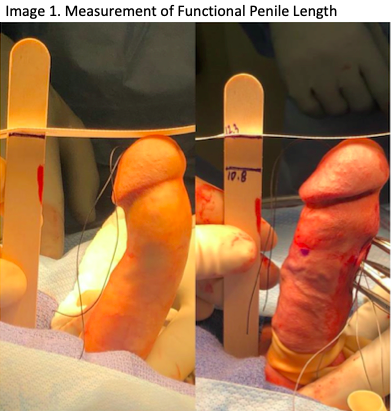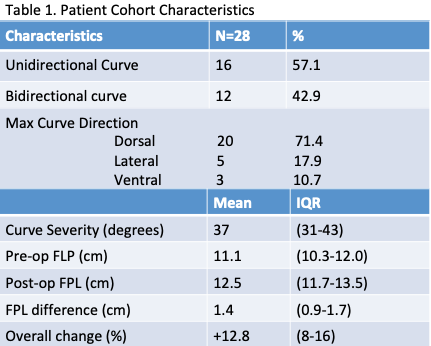Back
Poster, Podium & Video Sessions
Podium
PD23: Sexual Function/Dysfunction: Peyronie's Disease
PD23-06: Outcomes of Penile Plication in Peyronie's Disease - Functional Penile Length: "Empha-sizing" What Matters
Saturday, May 14, 2022
10:20 AM – 10:30 AM
Location: Room 255
Sarah Christianson*, Philadelphia , PA, Laura Douglass, Laura Kidd, Matthew Loecher, Michael Metro, Philadelphia, PA
- SC
Sarah S. Christianson, DO
Genitourinary Reconstructive Surgery Fellow
Podium Presenter(s)
Introduction: Surgical procedures for Peyronie’s Disease (PD) are classically categorized as tunical lengthening vs. shortening. Penile plication (PP) reduces penile curvature by placing plication sutures to shorten the convex side of the penis. While literature regarding PP outcomes demonstrates penile length reduction, there exists no standardization for measurement techniques leading to high inter-study variability. A majority of existing studies use length of the curve or stretched flaccid length. We utilize a novel measurement technique to measure Functional Penile Length (FPL), the length an intimate partner will experience, as a primary surgical outcome.
Methods: A prospectively maintained database of consecutive PD patients who underwent PP from 2019-2021 was queried. Patients were excluded if they required additional surgical procedures. All curve parameters were measured with artificial erection. Intra-operative assessment of FLP was performed prior to incision and after curve correction. We measure the penis from the base of the pubis to the tip of the glans, in a straight line and ignoring the curve (Image 1).
Results: 28 patients were eligible for analysis. 16/28 (47%) had unidirectional curve while 12/28 (43%) had bidirectional curve. Dorsal curvature was the most common and comprised 71% of the cohort. The average curve severity was 37 degrees (IQR 31-41). Mean FPL pre-operatively was 11.1 cm (IQR 10.3-12.0) and 12.5cm (IQR 11.7-12.4) post-operatively. This represented an average 12.8% increase in FPL following plication (Table 1). All 28 patients reported subjective improvement in their curvature.
Conclusions: FPL is a useful primary surgical outcome when describing post-operative expectations for patients undergoing surgical plication. We report an increase FPL achieved for PD treated with PP, despite being considered a shortening procedure. This is an invaluable tool for preoperative counseling and setting expectations for penile length.
Source of Funding: None


Methods: A prospectively maintained database of consecutive PD patients who underwent PP from 2019-2021 was queried. Patients were excluded if they required additional surgical procedures. All curve parameters were measured with artificial erection. Intra-operative assessment of FLP was performed prior to incision and after curve correction. We measure the penis from the base of the pubis to the tip of the glans, in a straight line and ignoring the curve (Image 1).
Results: 28 patients were eligible for analysis. 16/28 (47%) had unidirectional curve while 12/28 (43%) had bidirectional curve. Dorsal curvature was the most common and comprised 71% of the cohort. The average curve severity was 37 degrees (IQR 31-41). Mean FPL pre-operatively was 11.1 cm (IQR 10.3-12.0) and 12.5cm (IQR 11.7-12.4) post-operatively. This represented an average 12.8% increase in FPL following plication (Table 1). All 28 patients reported subjective improvement in their curvature.
Conclusions: FPL is a useful primary surgical outcome when describing post-operative expectations for patients undergoing surgical plication. We report an increase FPL achieved for PD treated with PP, despite being considered a shortening procedure. This is an invaluable tool for preoperative counseling and setting expectations for penile length.
Source of Funding: None



.jpg)
.jpg)